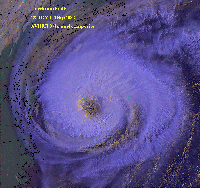Monthly News Summary – June 1998
Making Life Easier for the Navy
by Terri Gregory, SSEC Public Information Specialist
“Our Typhoon Duty Officers absolutely love the wind shear products being produced by Chris [Velden] and company in Wisconsin. It makes their life much easier. Thanks!”
Navy forecasters recently sent this appreciative email to the CIMSS (Cooperative Institute for Meteorological Satellite Studies) Tropical Cyclone group.
Chris, Tim Olander, and Steve Wanzong produce wind shear analyses using GOES satellite data and send it directly to the Navy over the Internet. Until recently, only the Navy had this real-time product. Now, it’s also freely available on the Tropical Cyclones Web site under Winds and Analyses.
The Naval Research Laboratory (NRL) in Monterey, California displays another of Chris Velden’s useful wind products on its Satellite Meteorology Web site. The Cloud and Water Vapor Winds page shows GOES wind measurements from different levels in the atmosphere. Used together, these measurements improve storm tracking and forecasting. The NRL also uses SSEC’s infrared image of the earth in its Long Period Satellite Movie display. It’s the full-globe composite at the bottom of that Web page.
For more information, follow the links below.
On the Air
For More Information
Goddard Space Flight Center POES Project
The National Oceanic and Atmospheric Administration (NOAA) successfully launched its newest polar-orbiting satellite on 13 May. Just before launch, NASA-TV used a McIDAS display from Vandenberg Air Force Base, with satellite data, map, and analyses, to show that the weather was good for launch.
CBS’s 50th anniversary program on 4 May used a McIDAS display to show how weather delayed the Space Shuttle Challenger’s fatal flight. TV viewer Matthew Lazzara said, “it was a nice display of a Tower or WWW Conrac [workstation] showing the clouds from GOES really well.”
In Print
For More Information
GOES-8 captured images of smoke from Mexico’s fires reaching all the way to Wisconsin. Scott Bachmeier relayed the news to Ron Seely of theWisconsin State Journal and the May 21 edition recounted CIMSS’ “major role in documenting the impact of the huge grass fires.” Scott used some of NOAA’s Air Resources Lab (ARL) air-mass trajectory products in our Web information about the fires. Through Scott’s conversation with ARL, news of smoke reaching Wisconsin also made it into theWashington Post.
The Oxford University Press will use a Hurricane Emily image on the cover of Robert Klee’s anthology, Scientific Inquiry. The image to be used is the three-color composite created by Dave Santek and others in September 1993.
Outreach and Education
For More Information
Wisconsin Initiative for Space Education
The University of Wisconsin System’s Office of Learning and Information Technology (OLIT) used SSEC’s outreach efforts as a recent topic in Teaching with Technology Today. The article notes the continuing successful efforts of Rose Pertzborn and Sanjay Limaye to teach Wisconsin students and teachers about space science. Successful projects include Red Rover and EarthKam. Red Rover grew from a summer project for a few seventh graders to a year-long science project teaching fourth and fifth graders about Mars. The EarthKam program involved science classes in two Madison middle schools, allowing students to remotely take pictures of the earth from the Space Shuttle and use them later in research.
Division of Planetary Sciences
Eye-catching postcards advertise the October meeting of the American Astronomical Society’s Division for Planetary Sciences (DPS). The postcard’s design incorporates pictures of the planets and the Monona Terrace Convention Center, where the meeting will take place in Madison. SSEC’s Sanjay Limaye, the meeting’s coordinator, outlined items planned for a public exhibit during the meeting in Madison Skies, the newsletter of the Madison Metropolitan School District Planetarium. Schools that want to be included in field trips to the meeting exhibits can email dps98@ssec.wisc.edu.
Wisconsin Initiative for Space Education
Honoring Dr. Suomi
This spring, NOAA and CIMSS presented the first Verner E. Suomi scholarship awards. Four 1998 graduates of Wisconsin high schools received $1000 scholarships toward their freshman year in a University of Wisconsin System undergraduate program in the physical sciences. The winners were chosen based on essays describing their science career goals, teachers’ recommendations, and high school transcripts.
The first four Verner E. Suomi scholars are listed below:
- Jason Brunner, Monona Grove
- Ryan Torn, Menominee Falls North
- Moire Prescott, Madison Memorial
- Lance Wamsley, Cassville
The award honors Professor Verner Suomi’s lifelong commitment to the education of undergraduate students. Suomi, known as the father of weather satellites for his inventions and development of satellite meteorology as a discipline, taught in the Department of Meteorology (now Atmospheric and Oceanic Sciences) from 1948 until 1994. He founded SSEC and directed it from 1965 to 1988.

